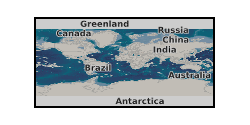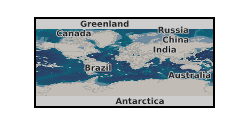Hydrodynamics
Type of resources
Topics
Keywords
Contact for the resource
Provided by
Years
Formats
Update frequencies
Scale
-

The North Sea Interactive (NSI) project was an 8-month NERC funded project led by Heriot-Watt University, in collaboration with the BGS and NOC. The aim of the project was to develop a new decision-support tool that would translate existing marine environmental data into an interactive mapping product for the offshore oil and gas industry. The objectives of the project were achieved through the integration of the North Sea Benthos database (UKBenthos) with NERC's regional North Sea marine sediment data (BGS) and layers of modelled hydrodynamics (NOC). Aligning the biological, chemical, geological and hydrodynamic datasets in a single GIS product provides the oil industry and government regulators with a practical means of accessing this important archive of environmental data. The North Sea Benthos database (UKBenthos) was developed by Heriot-Watt University on behalf of UKOOA (now Oil and Gas UK) in the 1980s. Alongside macrobenthos, the database includes sediment properties, concentrations of aromatic compounds, total oil and metals. It currently includes data from 1975 to 2011 from 237 platforms and is continually being updated as new survey results are received by Oil and Gas UK.
-

Bibliographic Data - Oral and Poster Presentations given by members of Work Package 5 of the HydroFrame (Hydromechanical and Biogeochemical Processes in Fractured Rock Masses in the Vicinity of a Geological Disposal Facility for Radioactive Waste) project. Presentations given between November 2014 and November 2016.
-

The spreadsheet gathers the data collected during a brine:CO2 flow-through experiment conducted on a weakly-cemented synthetic sandstone core sample using the multiflow experimental rig for CO2 experiments, designed and assembled at the National Oceanography Centre, Southampton. The test was configured to assess geophysical monitoring and deformation of reservoirs subjected to CO2 injection in shallow weakly-cemented (North Sea-like, e.g., Sleipner) CO2 storage sandstone reservoirs. The tests was conducted in the rock physics laboratory at the National Oceanography Centre, Southampton, during 2015-2016, as part of the DiSECCS project with funding from the United Kingdom’s Engineering and Physical Sciences Research Council (EPSRC grant EP/K035878/1) and the Natural Environment Research Council (NERC). The experiment was a steady state brine-CO2 flow-through test in which realistic shallow CO2 geosequestration conditions were simulated, to related geophysical signatures to the hydrodynamic and geomechanical behaviour of the rock sample. The confining and pore pressure conditions were similar to those estimated for shallow North Sea Sleipner-like, storage reservoirs, but simulating inflation/depletion cyclic scenarios for increasing brine:CO2 fractional flow rates. The data include ultrasonic P- and S-wave velocities and their respective attenuation factors, axial, radial and volumetric strains, and electrical resistivity; also relative permeability to both fluids (CO2 and brine) is displayed as a function of pore volume times, associated to increasing CO2 to brine contents in the sample.
-

Results files from computer simulations of fluid flow for 3D models of Ediacaran organisms and communities, generated using computational fluid dynamics. Simulations performed using the simulation software package COMSOL Multiphysics. Root folder names refer to initial trials ‘Cylinder Tests’), modern organisms (‘Chondrocladia lyra’), Ediacaran organisms (‘Pectinifrons’ and ‘Pterdinium’), and Ediacaran surfaces (‘Avalon’ and ‘White Sea’ surfaces). Sub-folder and file names refer to simulations performed with different models (e.g., ‘Base’, ‘Filled’ and ‘Flush’ Petridinium models), model orientations (e.g., 0°, 90°, and 180° to the inlet), current velocities (e.g., 0.15, 0.5 and 0.85 m/s), and turbulence models (e.g., Spalart Allmaras, shear stress transport, and large eddy simulation). Further details for Pectinifrons and Pteridinium available in Darroch et al. 2022 (https://doi.org/10.1017/pab.2022.2) and Darroch et al. 2023 (https://doi.org/10.1016/j.isci.2023.105989), respectively. Files can be opened with COMSOL Multiphysics (www.comsol.com) versions 5.6 or 6.0 and above.
 BGS Data Catalogue
BGS Data Catalogue